With the release last October of the strategic planning document “Reinvigorating the Air Force Nuclear Enterprise,” USAF unveiled a comprehensive plan to strengthen its handling of ICBM forces and nuclear-capable bombers. The service says that implementing this plan is top priority.
Now under way are numerous projects that seek to transform Air Force organizations, operations, and culture. They include the mammoth task of establishing a new major command, Air Force Global Strike Command, to bring together oversight of nuclear-armed Minuteman III missiles and B-2A and B-52H bomber units.
The goal is to restore high-quality, Cold War-style stewardship to USAF’s daily execution of its nuclear mission and, in the process, remove any lingering doubts about the service’s dedication on this score. Indeed, the standard by which airmen are judged will be nothing less than perfection.
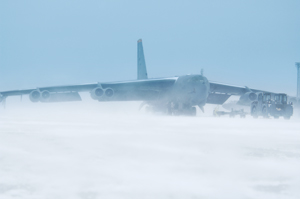 |
A B-52 Stratofortress is prepped for flight on the frigid flight line at Minot AFB, N.D. |
According to Maj. Gen. C. Donald Alston, assistant chief of staff for strategic deterrence and nuclear integration, “The roadmap is not about just overcoming deficiencies that have been exposed. It is about making sure that we are on this pathway to excellence that is our legacy.”
Alston, who spoke with Air Force Magazine in a November interview, heads the newly activated Air Staff A10 office that now serves as the focal point for nuclear matters at the headquarters level.
Several high-profile problems in the past several years caused the Air Force’s nuclear stewardship to come under extreme scrutiny, and shook the service. Centered on the mistaken shipment of Minuteman III nosecone components to Taiwan in August 2006 and the unauthorized transfer of nuclear-armed cruise missiles on a B-52 flight from North Dakota to Louisiana one year later, these missteps were considered by Secretary of Defense Robert M. Gates as “serious lapses” of oversight. They were cited as principal reasons for firing Air Force Secretary Michael W. Wynne and the Chief of Staff, Gen. T. Michael Moseley.
The roadmap is the Air Force’s way of showing how it is applying lessons of those disconcerting events. It incorporates insights and recommendations from senior-level internal and external reviews led by notables such as retired Gen. Larry D. Welch, a former Chief of Staff; James R. Schlesinger, a former Defense Secretary and Energy Secretary; and Adm. Kirkland H. Donald, director of naval nuclear propulsion.
Creating Strike Command is one of three pillars of the roadmap and is probably the action most visible to the outside world. In some ways, the new command harkens back to Strategic Air Command, the organization that oversaw nuclear bombers and ICBMs until June 1, 1992, when it was shut down.
Establishing the A10 office is the second pillar of the plan, and is already in place.
The third pillar is consolidating all nuclear sustainment functions under the Air Force Nuclear Weapons Center (AFNWC) at Kirtland AFB, N.M. Together, these three initiatives are seen as critical for the overall success of the reinvigoration efforts.
Supporting these pillars are activities such as more robust training for airmen, a stricter nuclear inspection regime, and new educational curricula and career opportunities to attract a new cadre of airmen in nuclear-related fields.
Merging Initiatives
Some corrective activities were already in progress prior to the roadmap’s release on Oct. 24, 2008, such as strengthening the AFNWC’s role and instituting nuclear-only wing rotations for the B-2s and B-52s under a construct called the Global Deterrence Force. But the document merges new initiatives with the earlier activities, many of which are now strengthened, and shows how they all fit together.
“This is long-term work, where success will be measured in years and not weeks,” said Secretary of the Air Force Michael B. Donley, in a November speech at the Center for Strategic and International Studies in Washington, D.C.
However, the impact is already being felt, even by Gates.
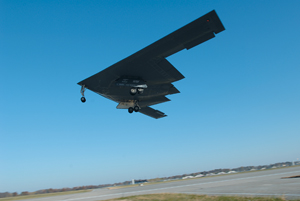 |
The B-2 |
“Based on everything I have seen, heard, and learned in recent months,” said the Pentagon chief, “I strongly believe that the Air Force is now moving in the right direction to reclaim the standards of excellence for which it was known throughout the Cold War.”
Gates made these remarks to an audience of airmen at Minot AFB, N.D., on Dec. 1, about five weeks after the roadmap’s release. Minot was the starting point for the errant B-52 flight with the cruise missiles in 2007.
The standup of Strike Command, to be led by a three-star general, will be phased, according to service officials involved in the process. In December, the Air Force leadership announced that Bolling AFB, D.C., will host the command’s provisional headquarters, which will be led on an interim basis by Brig. Gen. James M. Kowalski.
Initial operations of Strike Command are planned to commence at the end of September 2009, and the command is expected to be fully operational about one year after that.
The permanent headquarters location is undetermined, but members of Congress from states that host bomber bases or ICBM fields—such as Louisiana and North Dakota—have already begun lobbying hard to attract the HQ.
The headquarters could have upward of 900 personnel billets, including hundreds that transfer over from Air Combat Command and Air Force Space Command. These two commands are relinquishing their nuclear-capable bombers and ICBMs, respectively, to Strike Command.
ACC and Space Command are forming detachments in their respective headquarters at Langley AFB, Va., and Peterson AFB, Colo., to support the standup of the command, including working out the detailed basing plans and unit-manning issues. They will support the Strike Command commander remotely until the permanent HQ location is identified and Strike Command personnel may begin setting up there.
“My No. 1 concern is making sure that we get the right people in the right place at the right time and that we take care of them,” said Col. Sandra E. Finan, chief of Space Command’s nuclear operations.
The Real Challenge
Filling the new command’s headquarters with personnel having nuclear expertise is going to be a demanding task, noted Col. James Dunn, ACC’s nuclear enterprise director, in a December interview. “The real challenge for us,” he said, “is not in the spaces,” referring to the billets. “It is going to be in the faces—making sure that we have well-qualified people to actually go in there and perform the duties.”
Strike Command will oversee the nation’s 450 nuclear-tipped Minuteman III ICBMs, its 20 B-2As and soon-to-be 76 B-52Hs, and their subordinate units. This oversight will eventually include all of the functions for organizing, training, and equipping these forces. In addition to conventional munitions, the B-52s are capable of delivering nuclear-tipped cruise missiles and nuclear gravity bombs, while the B-2s can carry nuclear and nonnuclear bombs.
The Minuteman IIIs fall under 20th Air Force, headquartered at F. E. Warren AFB, Wyo. This numbered air force manages the 90th Missile Wing at F. E. Warren, 91st MW at Minot, and 341st MW at Malmstrom AFB, Mont. Each wing has 150 Minuteman IIIs.
The B-2s and B-52s fall under 8th Air Force, headquartered at Barksdale AFB, La. The lone exception is Air Force Reserve Command’s 93rd Bomb Squadron, a combat-coded B-52 unit at Barksdale that is transitioning to become the Air Force’s B-52 training squadron. Eighth Air Force’s B-52s are divided between the 2nd Bomb Wing at Barksdale and the 5th BW at Minot. Its sole B-2 wing, the 509th BW, is located at Whiteman AFB, Mo.
While all of 20th Air Force is transferring over to Strike Command, not all elements of 8th Air Force will join the B-2s and B-52s. Eighth Air Force’s intelligence-surveillance-reconnaissance aircraft will not transfer. Neither will its command and control platforms nor its cyber functions. ACC will redistribute them to other organizations. The cyber mission will move under Space Command’s 24th Air Force, a new organization.
While a transfer of fielded forces is anticipated at or around the time Strike Command begins initial operations, the Air Force is moving deliberately because the nuclear mission is so critical, the officials said.
“This is the nuclear business,” said Alston, architect of the roadmap, and now a leading figure in its implementation. “We are not going to transfer responsibility to operate forces in 20th Air Force and 8th Air Force until the commander of Global Strike Command says he is ready.”
In the case of the bombers, for example, not all command functions will shift from ACC until perhaps the time when Strike Command reaches full operational capability, said Dunn. This means that, upon assuming initial operations, Strike Command would focus primarily on its duties as a component major command to support US Strategic Command, while ACC still handles the administrative elements of the bombers’ operations.
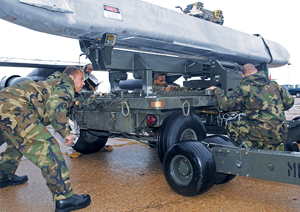 |
An Air Combat Command nuclear surety inspection team evaluates a Barksdale AFB, La., weapons load team from the 2nd Maintenance Squadron. |
The 2018 Bomber
The Air Force wants to field a new nuclear-capable bomber around 2018. Right now, ACC is establishing the requirements for the aircraft. But as Strike Command comes on, its commander will play a leading role in the process, just as he would be expected to be at the forefront of advocating any other Air Force nuclear program, said Alston.
Strike Command’s role will not be strictly nuclear; it will also be responsible for supporting STRATCOM’s conventional global strike missions. Unlike Strategic Air Command, the new command will not have embedded ISR, command and control, or tanker assets.
While Air Force Space Command anticipates eventually relinquishing all functions related to the ICBM force, Air Combat Command will retain some functions tied to the bombers. Among them, Dunn said, ACC will remain the lead for ensuring that the B-2s and B-52s can continue to integrate with the combat air forces in nonnuclear roles to support theater commanders and contingencies.
“There is no doubt that … our priority is on the nuclear mission of those bombers, but they also have immense conventional capability that we want to retain,” he said.
The Air Force has F-15E and F-16 fighters that can strike with nuclear weapons, if called upon. These will not be moved under Strike Command, however. And USAF’s B-1 bomber force, capable today only of conventional missions, will remain under ACC.
Strike Command will be supported by the Air Force Nuclear Weapons Center, which opened in 2006, but is being expanded under provisions of the nuclear roadmap.
From 1950 until 1995, the Air Force maintained one central hub for nuclear sustainment at Kelly AFB, Tex. A base-closure decision in 1995 led to the shutdown of the base, and sustainment functions thereafter have been dispersed.
In the early 2000s, the Air Force realized that nuclear sustainment had become too fragmented and could lead to problems. This led to creation of AFNWC to be the center of excellence for these activities and primary interface with the Department of Energy for nuclear weapons.
However, in the wake of the 2006 errant shipment of Minuteman III components to Taiwan—a slip-up that came to light only last March—the Air Force decided to do even more with the center to streamline the sustainment.
“We are totally involved,” said Brig. Gen. Everett H. Thomas, AFNWC commander, of the center’s strengthened role during a November interview. Thomas assumed his post in April 2008.
This involvement starts from the very first inkling about sustaining a nuclear weapon system, Thomas said, referring to this comprehensive approach as “lust-to-dust” vigilance.
The center is now the hub for ensuring the safety, security, and reliability of Air Force nuclear weapons as well as the certification of nuclear delivery systems and integration of their equipment. (ICBM sustainment moved from Air Force Space Command under AFNWC’s authority last May.)
To support this oversight, the center is adding about 280 personnel, including growing its professional staff from 14 to 98, he said. The expanded staff will have expertise in areas such as contracting, plans and programs, requirements, systems engineering, and logistics.
The center is also taking over responsibility from the Defense Logistics Agency for all Air Force nuclear weapons-related materials and will exercise positive inventory control over them. Lack of PIC was cited in reviews such as Donald’s as a contributing factor in the errant shipment of Minuteman III components to Taiwan.
Further, to bolster the sustainment chain, the commander of Air Force Materiel Command is now “the single voice for nuclear sustainment” and the biggest advocate for its funding across the Air Force, Thomas said.
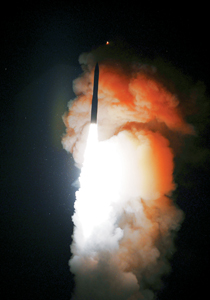 |
A Minuteman III ICBM blasts away from Vandenberg AFB, Calif., toward a test target near the Kwajalein Atoll in the Marshall Islands. |
More To Come
Some changes are yet to come. For example, Alston said, when the time comes, any new-start nuclear-related major acquisition programs likely would be moved under the authority of the AFNWC as opposed to residing in an Air Force product development center, as they have in the past.
Now that the A10 office has stood up—its formal activation date was Nov. 1, 2008—the focus is on fortifying its role, said Alston. The office reports directly to the Chief of Staff. Creation of the office elevated nuclear matters to the highest levels of the Air Force, replacing the post-Cold War organizational construct in which no general officers across the Air Force occupied themselves daily with nuclear issues.
The A10 will always be closely integrated with other functions on the Air Staff, but it is “growing more organic capacity,” said Alston. For example, he intends to build a robust capacity in-house for generating nuclear requirements. Functions such as nuclear security will also come under the control of his office.
Alston said there is “a sense of common purpose” across the Air Staff in reinvigorating the nuclear mission. “I have got nothing but great support for everything that I am doing,” he said, adding that he has had “fantastic access” to Donley and Gen. Norton A. Schwartz, USAF Chief of Staff.
The A10 head will also be the executive secretary of the new Nuclear Oversight Board that is chaired by the Air Force Secretary and Chief of Staff, and includes members such as USAF’s inspector general and the heads of the major commands with nuclear responsibilities. The board is expected to meet quarterly; its inaugural session took place Dec. 10.
“Job 1 is to implement the roadmap, and … this is also going to be a key body by which we expose progress,” Alston said of the NOB.
Alston’s office is also solidifying relationships with the Air Force’s defense and interagency partners in the nuclear mission such as the Defense Threat Reduction Agency and Department of Energy’s National Nuclear Security Administration. And it is ironing out how to best support Strike Command and the Air Force Nuclear Weapons Center, he said.
The A10 will also partner with the senior-level civilian who will occupy the post that is being created in the Office of the Undersecretary of the Air Force with responsibility of policy oversight for nuclear matters in the Secretariat.
The Air Force spends about 3.5 percent to five percent of its annual budget on the nuclear mission. This amount is expected to grow. But Alston said right now it is difficult to look at dollar figures and draw meaningful conclusions as to how they reflect the Air Force’s commitment to the nuclear mission.
This is because the service’s forthcoming Fiscal 2010 multiyear budget plan focuses on accelerating existing programs and standing up a fourth B-52 operational squadron for the GDF. “We are not advocating for new starts of programs at this time,” he said.
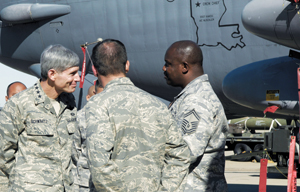 |
Gen. Norton Schwartz, USAF Chief of Staff, speaks to maintainers at Barksdale about their mission. |
Observers will be able to glean better insights in the next full budget cycle when the Air Force is able to take “a more proactive stance with regards to nuclear requirements,” he said.
Just as finding headquarters personnel for Strike Command will be a challenge, so, too, will be finding qualified personnel to populate the A10 and the expanded AFNWC fully, Alston said.
Nuclear specialties will receive new authorizations as the Air Force grows from an active duty end strength of 316,000 to 330,000.
“The authorizations do not become the challenge. It is the talent and the nuclear expertise that becomes the challenge. We need to ensure that we have the right guys in the right jobs,” said Alston.
| Positive Inventory Control
The Air Force has always maintained precise tabs on its nuclear weapons in storage, but with the end of the Cold War, let oversight of its nuclear weapons-related materials, or NWRM, wane. This is changing as positive inventory control is being reinstituted in phases. At first, the process will be manually intensive until greater automation is introduced. Under Phase I, the service has already identified all NWRM items, about 160 national stock numbers mostly associated with the ICBM fleet. They had been dispersed at various locations within the Defense Logistics Agency’s standard supply chain, and there were limits on tracking their whereabouts. The Minuteman III nosecone components sent mistakenly to Taiwan in 2006 are examples of NWRM. Plans are to start moving NWRM early this year into a single facility, a refurbished 48,000-square-foot warehouse on the grounds of Hill AFB, Utah, that the Air Force will run. “We are going to control every component … until it is released to the maintenance organization,” said Brig. Gen. Everett H. Thomas, commander of the Air Force Nuclear Weapons Center at Kirtland AFB, N.M., in explaining what PIC will mean. In the case of an ICBM part, for example, “we will issue it, and when it is put on the ICBM, we will be able to tell you exactly which ICBM that part is on,” he said. In Phase II, several hundred so-called nuclear-related materials will be incorporated under PIC and tracking automation will be enhanced. NRM are auxiliary pieces and parts, like a shim on an ICBM. Phase III is scheduled for completion in 2013. It involves migrating control of the NWRM and NRM to the Expeditionary Combat Support System, a new logistics electronic records program. This will allow for fully automated PIC with real-time visibility and serial number tracking. |
| Global Deterrence Force
Three weeks before the Air Force in October issued its nuclear roadmap, the service began the Global Deterrence Force rotation for its B-2A and B-52H bombers. The idea for the force came from a February 2008 recommendation of the Defense Science Board Permanent Task Force on Nuclear Weapons Surety. The GDF is designed to sustain nuclear expertise among the B-2A and B-52H units and create a balance between their nuclear deterrence mission and current conventional operational requirements. “We are using the GDF to provide a focused training venue so that we can increase nuclear experience and the readiness of our force. … But we intend to retain conventional ability and credibility also,” said Col. James Dunn, nuclear enterprise director for Air Combat Command. The GDF construct calls for the Air Force’s two B-52H bomber wings, the 2nd Bomb Wing at Barksdale AFB, La., and the 5th BW at Minot AFB, N.D., to switch in and out of the GDF on one-year intervals. During the year in the GDF, the respective B-52H wing will focus primarily on training for the nuclear deterrent mission; each of its two operational squadrons will spend an interval of six months of that year specifically concentrating on that training. The 2nd BW is now in the GDF with its 96th Bomb Squadron first up for the nuclear concentration. The initial GDF rotation of B-52s is not for a full year, as the 2nd BW will conclude its stint already at the end of March. When the 5th BW takes over in April, it will be for a full year. The service’s sole B-2A wing, the 509th BW at Whiteman AFB, Mo., is part of the GDF at all times, but some of its elements will continue to support conventional Air and Space Expeditionary Force (AEF) deployments or the four-month rotations to Guam, where the US maintains a continual bomber presence to dissuade aggression in the Pacific. The units of the B-52H wing outside of the GDF will continue to be a part of AEF deployments to support conventional operations in places such as Southwest Asia, or will deploy to Guam. To support the GDF, the Air Force is bringing back to combat status about one dozen B-52Hs that had been maintained in a lesser state of readiness so that it may establish a fourth B-52H operational squadron, for proposed basing at Minot. Initial operations of the squadron are anticipated at the end of September, but are dependent upon the completion of the environmental impact analysis. |
| Regardless of Size
The changes that the Air Force is making to bolster its nuclear stewardship are meant to be equally effective regardless of any changes in the size of the service’s bomber and ICBM forces. “Indeed, I would argue that our commitment to this mission needs to be independent of size,” said Air Force Secretary Michael B. Donley during a Nov. 12, 2008 speech at the Center for Strategic and International Studies in Washington, D.C. But if President Barack Obama does reduce the size of the nation’s nuclear forces, he should keep in mind that maintaining the flexibility of options across the deterrent “becomes even more important,” Donley said. That’s why the nuclear-capable bomber leg would still have a valuable role to play, along with the land-based ICBMs and submarine-fired ballistic missiles, because it “complicates attack planning and allows the United States to signal, to deploy forces without fully committing [them],” he said. Obama has said that his Administration will “maintain a strong deterrent as long as nuclear weapons exist.” But it will otherwise “stop the development of new nuclear weapons,” and “seek dramatic reductions in US and Russian stockpiles of nuclear weapons and material.” The United States is already obligated under the 2002 Moscow Treaty to reduce the number of its deployed strategic nuclear warheads to between 1,700 and 2,200 by the end of 2012, but is expected to meet that goal by the end of 2010. |
